Plus ones, and retweets and Likes – oh my. The personal, social side of search is quickly becoming part of any SEO conversation and it was a leading topic at this week’s SMX West conference. But are shares more important than links? And what do Google and Bing consider “personal information” when they deliver custom results to users?
More importantly for marketers, “How can webmasters become ‘popular’ in a social search world?” Both Bing and Google advocate quality content marketing, with Jack Menzel (product manager at Google) saying quite simply, “Make content people want.” Still, to garner the most web visibility in the age of personal search bubbles, understanding how the landscape works can help inform strategies.
Here are some insights from SMX shared by Google’s Menzel and Bing’s Paul Yiu and Rangan Majumder about what goes into social and personal search – and what businesses can do to stay on top.
What personalization (non-social) factors do search engines use?
Whether or not searchers are logged into social accounts, Google and Bing are working to give customized results. These engines consider everything from your location, your search history and your preferred websites when deciding which results might be relevant to users. As Danny Sullivan pointed out, website owners and marketers should take this as a sign that SEO rankings reports are dead: As it stands, just about every user is getting unique results for the same SERPs.
“Search used to be all about matching query text to document text, but now it’s all about context.”
– Ranjun Majumder, principal group program manager at Bing
At Google, context information and other personal factors (beyond social) that inform SERPs include a user’s location, language, the context Google picks up from related queries and patterns or preferences in sites it detects for individual users. 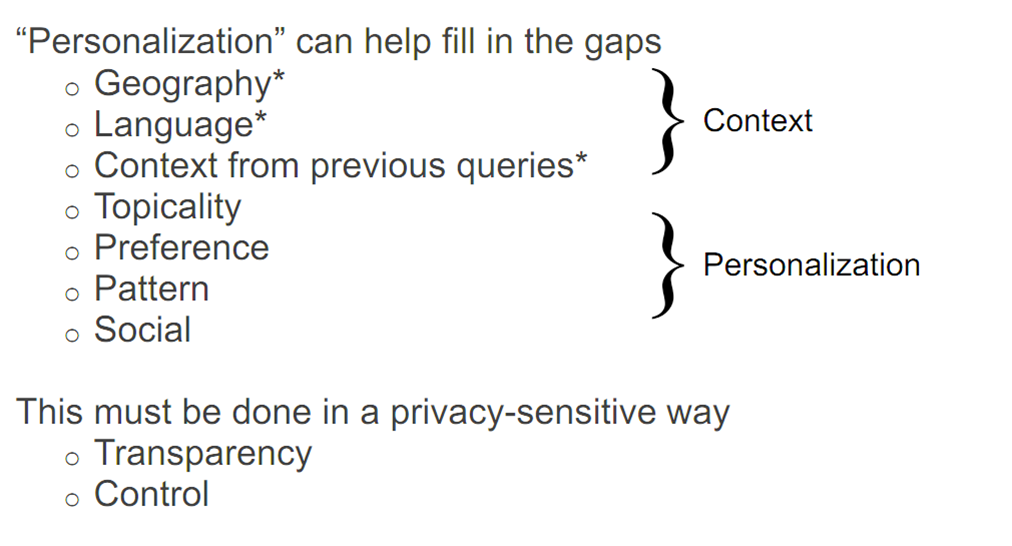
The geographic component is now down to the sub-level where search engines don’t just look at Los Angeles, but also at specific neighborhoods to determine what could be most relevant to a user.
Menzel offered some nice visuals for how different Google searchers might see results based on the “personalization” data Google uses to fill in the gaps.
For instance, a person conducting a search for taxes in the U.S. would see completely different results compared to a searcher using the same query in the U.K.
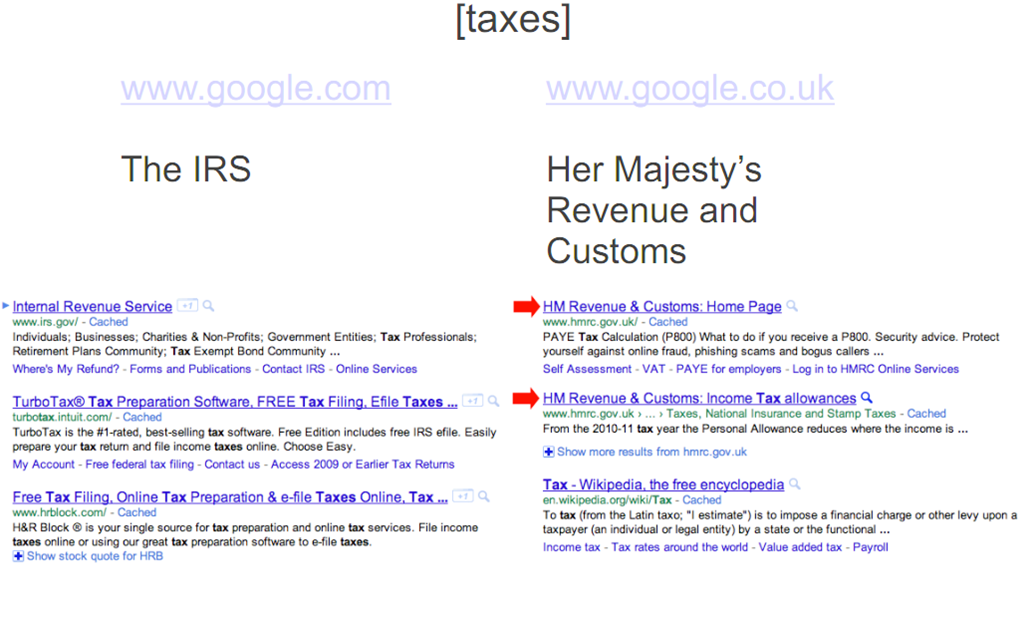
Another personalization factor is previous queries or patterns across the web. Someone who had searched for “lawn mowers” and then searched for “Amazon” might see Amazon results specifically for lawn mowers higher on the SERP than other users.
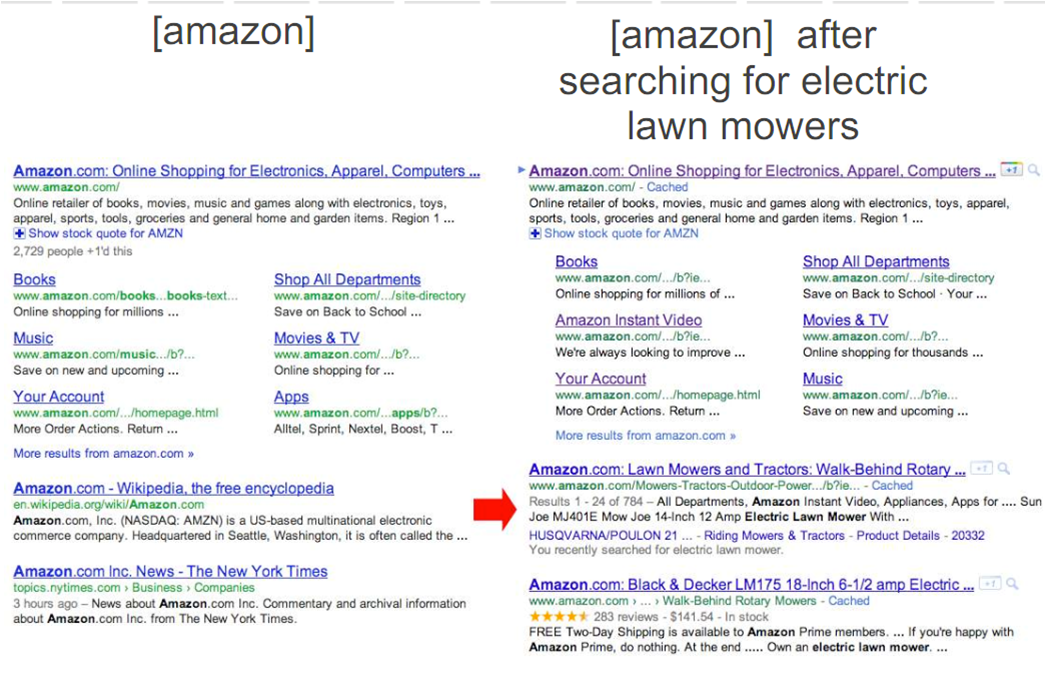
Also, Google will take website preferences or perceived patterns into account. Most people searching the web for “dominion” will see resuts for the power company, but someone who has a search history of looking for the card game by the same name might see results for the game prioritized in SERPs.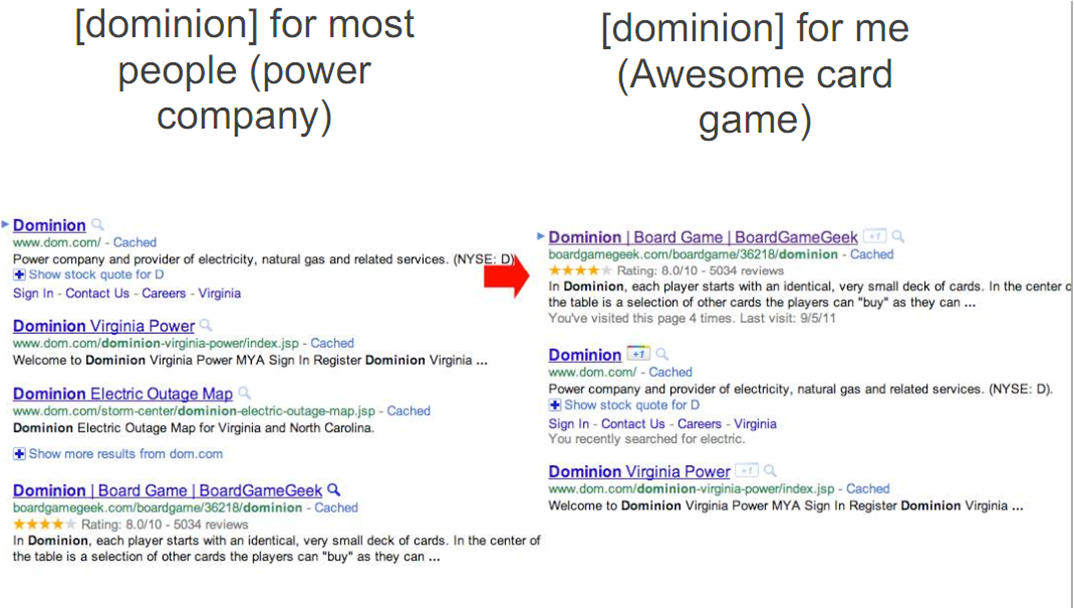 Majumder said Bing has similar features in place. He outlined the new formula for Bing SEO:
Majumder said Bing has similar features in place. He outlined the new formula for Bing SEO:
Rank = Authority + Keyword Match + Personal Preference + Social Preference
Bing engineers consider at how much they think users will like the content based on past behavior and Likes (but we’ll get into the more “social” elements in a moment). Brafton has reported that Bing’s Adaptive Search feature uses search patterns to identify personal intent even if users say they do not want their histories enabled.
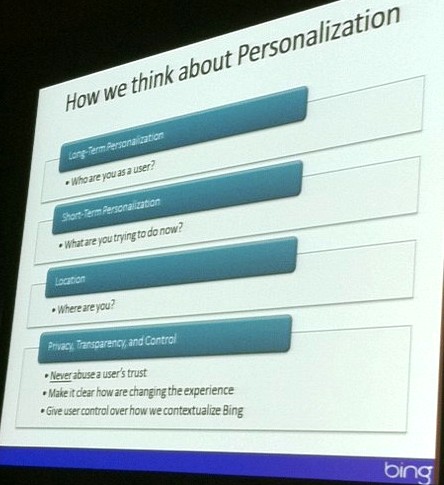 With Bing, Majumder showed how personalization starts even before the SERP. Typing in a query that starts with “S,” autosuggest yields a mixture of popular sites and local results. If a user is in a different location, the suggestions would be different. He explained Bing’s approach to personalization as tiered: Long term personalization is focused on, “Who are you?” Short term personalization considers, “What are you doing now?” Location factors in,” Where are you?” But privacy is essential throughout the process.
With Bing, Majumder showed how personalization starts even before the SERP. Typing in a query that starts with “S,” autosuggest yields a mixture of popular sites and local results. If a user is in a different location, the suggestions would be different. He explained Bing’s approach to personalization as tiered: Long term personalization is focused on, “Who are you?” Short term personalization considers, “What are you doing now?” Location factors in,” Where are you?” But privacy is essential throughout the process.
The session focused a lot on the question of discovery versus being “force fed results based on personalization bubbles,” but Majumder was quick to point out that relevant content would still pull rank over search history. Google agreed, with Menzel saying, “You shouldn’t see irrelevant content because you visited a site before.” He was quick to point out that good content is more of a must than ever.
Executives from both companies said the standard practice is to draw on about 180 days of search history for filling in the gaps. And, although Menzel wouldn’t “swear to it,” he said that when users disable their search histories, Google won’t use cookie history for search personalization.
So some of the big marketing takeaways about contextual results include:
- Location optimization is key. A Google tip from Menzel: One of the most important things a business can do is claim their Google Places page and make sure all of the information on it is correct so they can be part of the location element of personalized results
- Ranking reports aren’t a great SEO metric anymore. The results will be different for different users – and we haven’t even gotten into the social media factors yet! While rankings reports can be a nice (limited) way to track progress, it’s hard to grasp how a site ranks for keywords since no one is searching in a vacuum!
- Pay attention to returning visitors and try to do more to win repeat traffic. If site preference is playing a role in search visibility, it will work to your site’s benefit if it is deemed a niche authority. And on the note of building that authority…
- Content marketing is huge. As Majumder said, “Users no longer have to settle for what’s best for average, they can get what’s best for them,” and both search representatives said that “good content” is essential to breaking through the personalization bubble.
Remember, all of this personalization is happening before a user even logs into their social accounts – but Bing and Google executives had a lot to say about the social data used for search, too.
What social signals do search engines use?
Ever since the launch of Search, plus Your World, users and marketers alike have been concerned about how much influence the social network has over search results. In fact, Brafton has reported that almost half of users say they don’t like their social data impacting their searches. But Google’s Jack Menzel believes the web is “not just about public content, but also content that is privately shared with me,” and he (and Google) think it’s better for users to see results custom to them – not just in terms of their location or search patterns, but also in terms of what their friends endorse on the web.
“Identity allows for interactivity, and we want the web to be about conversations,” said Menzel. This is where Google+ comes in. Content shared by users’ friends, created by users’ friends and/or recommended by users’ friends on the search giant’s network can all be boosted in their SERPs.
 A question came up about whether there would be any way for users to de-emphasize results from specific Circles or connections. For example, if you keep getting restaurant-related results from a friend you think has poor taste in food would Google to know your never click on this friend’s recommendations and weed them out? Menzel said at present there is no such solution. (Bing, too, said users would have to “skip over” results advocated by certain friends if they didn’t want these users’ input.)
A question came up about whether there would be any way for users to de-emphasize results from specific Circles or connections. For example, if you keep getting restaurant-related results from a friend you think has poor taste in food would Google to know your never click on this friend’s recommendations and weed them out? Menzel said at present there is no such solution. (Bing, too, said users would have to “skip over” results advocated by certain friends if they didn’t want these users’ input.)
Although he went on to encourage marketers to share their content across a variety of social platforms, Menzel hinted at the fact that Google+ is what most impacts search visibility for Google users. When directly asked about whether the company uses Facebook Like data, he said, “We don’t have access to all the social data. For all those interactions going on, we can’t use all of them.”
Google looks at public data for the leading sites (Facebook, Twitter and Google+ were mentioned – sorry LinkedIn!), and Menzel went on to say that Google doesn’t attempt to do any customization based on smaller or burgeoning social networks. He referenced Pinterest as a site they are waiting to see more growth on before working it into social results (though Brafton has reported that Pinterest is growing fast – and some have even speculated that Pinterest could outpace Google+…).
Instead of worrying about the nuances of shares for sites Google can’t access, Menzel said, “Freshness is very important and looking at how people are talking about a topic on the internet is a good signal. We want to know if its popular, even if we don’t have every interaction.”

Freshness as a metric for what is socially popular is big at Bing, too. Paul Yiu, group program manager at Bing, described how trending social topics often impact the SERPs for related queries. For instance, after Angelina Jolie flashed her leg at the Oscars, content about her right leg was given prominence in searches for the actresses’ name, outranking sites that would normally rank best for the same search term.
Bing operates with what is publicly available. Of course, the Friend Effect lets them sync Facebook data for individual users sometimes impacting ranking and often, as Yiu put it, “decorating results” with Like data.
He explained that Microsoft’s search engine is focused on coming up with ways to let “people influence search.” As with priority for social trending topics, this isn’t always done in a custom way, but can be achieved through considering aggregate social data. He said social is about:
1. Aggregate and real time information
2. Personally relevant results
Overall, Bing treats social search as if people have influence in numbers. But he warned marketers about going for quality over quantity. Yiu said marketers should be careful of who they follow on Twitter, or else Bing might “misunderstand your relationship” with spammy accounts.
He encouraged publishers to show real-time info to their users (and this is advised for Google SEO, too, where the freshness factor algorithm considers the timeliness of content as a ranking signal). He also pointed out that “having high-quality content is key to rising above the noise.”
Google said very much the same thing, with Menzel reporting that, “to the extent that Google can aggregate social data for general rankings, total number of shares is a general SEO signal.”
The key takeaways for marketers about social results include:
- You need to be sharing content. Menzel argued that Twitter, Facebook and Google+ sharing via +1 buttons are most important for SEO. Going further into sharing with Google+, Menzel advised marketers to:
- Create a Google+ Page and link it to your websites with rel=publisher
- Use the author rich snippets
- Encourage visitors to interact with content AND content authors
- Share links to your site content as part of social marketing, considering the Tweet or post itself to be the “teaser.” The link to more info and more unique insights is what will set a brand apart. For Bing, social shares with links are treated as higher quality, and Google says Tweets with links help SEO.
- On a related note, make sure the site content you are using to fuel social is substantive, as this will drive sustainable social clout. “The content that people enjoy and share across the web says more than a single sentence.”
- Keep content marketing strategies up to date and consider how trending topics are relevant to your unique business audiences. With a focus on freshness and socially popular topics, businesses that can successfully connect their brand or business goals to trends in the form of valuable blogs or news content marketing stand to gain.
Is social marketing the new linkbuilding for SEO?
In light of the heavy emphasis of social factors in search optimization, many marketers might think social is the new linkbuilding. But Google and Bing affirm that social marketing is still a piece of the puzzle. It’s important to get links to your site content in social shares, but the influence of links from high-quality sites (in addition to links from authoritative users) still has its place.
What else should marketers know about modern SEO?
Beyond “everything you need to know about personal search,” the experts in attendance gave marketers some tips about modern SEO. Here are key points:
1. Don’t use flash! Computers are “stupid” and don’t know how to read it. No matter how pretty flash sites look, Google advised marketers to avoid avoid avoid.
2. Mobile is your underused SEO weapon. With such a high volume of searches coming from mobile devices, considering the local elements of search and the need for frequent updates for constant on-the-go searches can give businesses an edge.
3. Bounce rates matter. As Majumder said, “People don’t bounce away from good sites.” The search engines consider bounce rate when determining search rankings, and experts from both engines say to look at content when trying to reduce bounces. (See Brafton’s related articles about top strategies for reducing bounce rates.)
The search landscape is constantly changing, but all of the major search engines are encouraging website owners to strive for one goal: Create a site that benefits users. Creating an optimal user experience through unique and valuable content as well as intuitive navigation arms a site with SEO fuel in the face of constant search updates. As Menzel said, “Nothing bad will happen to you for having a site that works, for making it easy for consumers to get to your content.”

